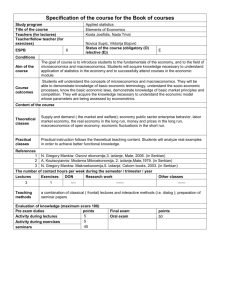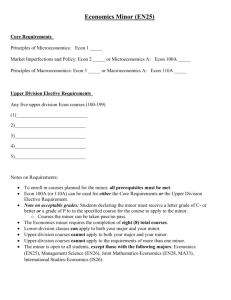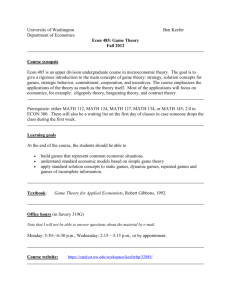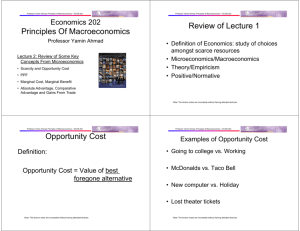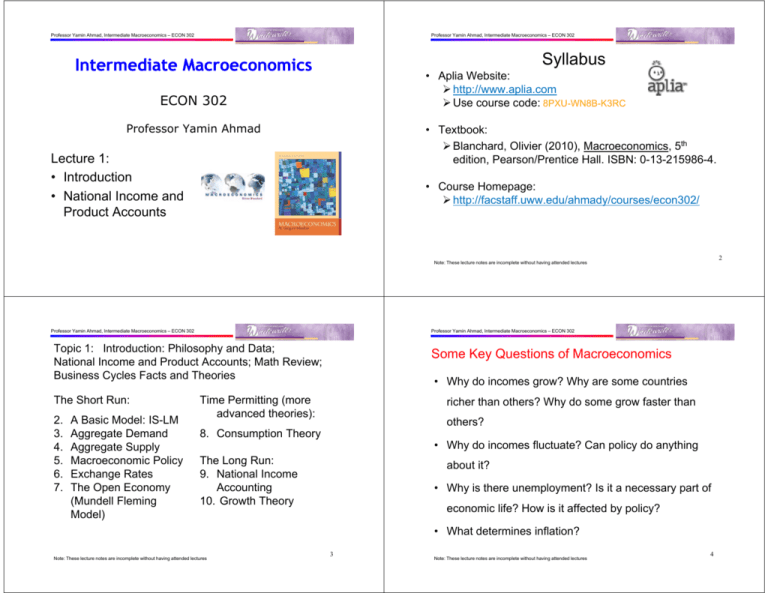
Professor Yamin Ahmad, Intermediate Macroeconomics – ECON 302
Professor Yamin Ahmad, Intermediate Macroeconomics – ECON 302
Syllabus
Intermediate
d
Macroeconomics
• Aplia Website:
http://www.aplia.com
p
p
Use course code: 8PXU-WN8B-K3RC
ECON 302
Professor Yamin Ahmad
• Textbook:
Blanchard, Olivier (2010), Macroeconomics, 5th
edition, Pearson/Prentice Hall. ISBN: 0-13-215986-4.
Lecture 1:
• Introduction
• National Income and
Product Accounts
• Course Homepage:
http://facstaff.uww.edu/ahmady/courses/econ302/
http://facstaff uww edu/ahmady/courses/econ302/
2
Note: These lecture notes are incomplete without having attended lectures
Professor Yamin Ahmad, Intermediate Macroeconomics – ECON 302
Professor Yamin Ahmad, Intermediate Macroeconomics – ECON 302
Topic
p 1: Introduction: Philosophy
p y and Data;
National Income and Product Accounts; Math Review;
Business Cycles Facts and Theories
The Short Run:
2.
3.
4.
5
5.
6.
7.
A Basic Model: IS-LM
Aggregate Demand
Aggregate Supply
Macroeconomic Policy
Exchange Rates
The Open Economy
(M d ll Fleming
(Mundell
Fl i
Model)
Some Key Questions of Macroeconomics
• Why do incomes grow? Why are some countries
Time Permitting (more
advanced theories):
richer than others? Why do some grow faster than
others?
8. Consumption Theory
• Why do incomes fluctuate? Can policy do anything
The Long Run:
9. National Income
Accounting
10 Growth
10.
G
th Theory
Th
about
b t it?
• Why is there unemployment? Is it a necessary part of
economic life? How is it affected by policy?
• What determines inflation?
Note: These lecture notes are incomplete without having attended lectures
3
Note: These lecture notes are incomplete without having attended lectures
4
Professor Yamin Ahmad, Intermediate Macroeconomics – ECON 302
Professor Yamin Ahmad, Intermediate Macroeconomics – ECON 302
Structure of Different Models
To address these questions we need to know…
•
• How individuals behave (“microfoundations”)
Models embody assumptions about individual behavior, market
structure and what is exogenous (including policy regime).
•
• How
H
iindividuals
di id l iinteract (“
(“market
k t structure”)
t t ”)
Solution gives us the endogenous variables in terms of the
exogenous factors.
• How government enters the picture (both the
•
feasibility of policy and the incentives facing policy
Models should be simple and focus on issue at hand. Do not
need to be “realistic”, but should be consistent with the facts.
makers)
•
Can switch between models according to context; no grand
“t ” model.
“true”
d l
Note: These lecture notes are incomplete without having attended lectures
5
Professor Yamin Ahmad, Intermediate Macroeconomics – ECON 302
6
Professor Yamin Ahmad, Intermediate Macroeconomics – ECON 302
More on Endogenous and Exogenous
Variables
Mathematical functions
• We use functional notation when we want to express
the idea that one variable is determined by other
variables.
• Variables that are exogenous in some models might be
endogenous in other models.
For example, in one macro model, we might take interest
g
rates as exogenous.
But some economic models are designed exactly to explain
interest rates.
For example, supply of pizzas is a function of the price of
pizzas and the price of materials (price of inputs):
Q s S (P , Pm )
• In some cases, a variable is exogenous in the building
block of a more general model, but endogenous in the
general model
model.
• In this example, the quantity supplied of pizza is the
“endogenous”
endogenous variable in the pizza supply model
model.
The price of pizza and the price of materials are “exogenous”
for the pizza maker under perfect competition. He cannot
influence those prices (assuming that he is not a monopoly
seller of pizza!)
Note: These lecture notes are incomplete without having attended lectures
Note: These lecture notes are incomplete without having attended lectures
7
Price of pizza is exogenous for the pizza supplier, but
determined within our model of the pizza market.
Note: These lecture notes are incomplete without having attended lectures
8
Professor Yamin Ahmad, Intermediate Macroeconomics – ECON 302
Professor Yamin Ahmad, Intermediate Macroeconomics – ECON 302
Example: The Pizza market
Macroeconomic example
• We can take the equations for supply of pizza,
demand for pizza,
pizza and market equilibrium:
• We will model aggregate consumption as depending
on “disposable”
disposable income:
C C (Y T )
Q s S (P , Pm )
For consumers in this model, income and taxes are
exogenous
exogenous.
But aggregate income will be determined in our macro
model.
Q d D (P ,Y )
Qs Qd
• P and Pm are exogenous for the pizza supplier. P
and Y are exogenous for the pizza demander.
• These three equations together determine Qs, Qd,
and P endogenously. The exogenous variables for
the pizza market are Pm and Y.
• In most of our macro models, aggregate taxes will be
exogenous, but sometimes they will be endogenous.
• In most of our models of consumer’s income is
exogenous, but sometimes it is endogenous. Income
depends on how many hours we work
work, for example
example.
9
Note: These lecture notes are incomplete without having attended lectures
Professor Yamin Ahmad, Intermediate Macroeconomics – ECON 302
Note: These lecture notes are incomplete without having attended lectures
Professor Yamin Ahmad, Intermediate Macroeconomics – ECON 302
Common Strands Amongst Recent Macro
Models:
Simple Problem
Review how to solve endogenous variables:
• Individuals and firms optimize
p
• Task: Solve for P and Q, in terms of Pm
and Y:
• Rational Expectations in the long run
Q a bP cPm
• Prices
Pi
flflexible
ibl iin th
the llong run
Q d eP fY
a, b, c, d, e, and f are “parameters”. For
example e tells us how much demand falls
example,
when the price rises.
Note: These lecture notes are incomplete without having attended lectures
10
11
Also frequently:
• Perfect
f
Competition:
C
May be unrealistic, but often
f
a
useful simplification
Note: These lecture notes are incomplete without having attended lectures
12
Professor Yamin Ahmad, Intermediate Macroeconomics – ECON 302
Professor Yamin Ahmad, Intermediate Macroeconomics – ECON 302
Important Concepts…
Concepts
C t
Controversial
i l IIssues
• Gross Domestic Product (GDP)
• Are prices flexible in the short run?
• Components of GDP
• How important are “frictions” and “mistakes” in the
short run?
• Gross National Product (GNP)
• Are market imperfections (monopolistic competition
competition,
• Price Indices:
etc.) important for understanding macroeconomic
GDP Deflator
The Consumer Price Index (CPI)
phenomena?
h
?
• The Unemployment Rate
Note: These lecture notes are incomplete without having attended lectures
13
Professor Yamin Ahmad, Intermediate Macroeconomics – ECON 302
Note: These lecture notes are incomplete without having attended lectures
Professor Yamin Ahmad, Intermediate Macroeconomics – ECON 302
Aggregate Output
GDP: Production and Income
There are three ways
y of defining
g GDP:
• National income and product accounts are an
accounting system used to measure of aggregate
economic activity.
1.
GDP is the value of the final goods and services produced in
the economy during a given period.
• The measure of aggregate output in the national
income accounts is gross domestic product,
product or
GDP.
• In the United States, the Bureau of Economic
Analysis calculates GDP and components of the
National Accounts (NIPA Table 1.1.5)
1 1 5)
Note: These lecture notes are incomplete without having attended lectures
14
2.
GDP is the sum of the incomes in the economy during a
given period.
3.
GDP is the sum of value added in the economy during a
given period.
15
A final good is a good that is destined for final consumption.
An intermediate good is a good used in the production of
another good.
Value added equals the value of a firm
firm’ss production minus the value of
the intermediate goods it uses in production.
Note: These lecture notes are incomplete without having attended lectures
16
Professor Yamin Ahmad, Intermediate Macroeconomics – ECON 302
Professor Yamin Ahmad, Intermediate Macroeconomics – ECON 302
Gross Domestic Product: Expenditure and
Income
For first two definitions:
Th Ci
The
Circular
l Fl
Flow
Income ($)
Total expenditure on domestically-produced
final goods and services.
Labor
Total income earned by domestically-located
factors of production.
Expenditure equals income because
every dollar spent by a buyer
becomes income to the seller.
Note: These lecture notes are incomplete without having attended lectures
Goods
Expenditure
p
($)
17
Professor Yamin Ahmad, Intermediate Macroeconomics – ECON 302
Note: These lecture notes are incomplete without having attended lectures
18
Professor Yamin Ahmad, Intermediate Macroeconomics – ECON 302
Value Added Approach: (Exercise)
Final goods, value added, and GDP
A farmer grows a bushel of wheat and sells it to a
miller for $1.00.
The miller turns the wheat into flour and sells it to
a baker
b k ffor $3
$3.00.
00
The baker uses the flour to make a loaf of bread
and sells it to an engineer for $6
$6.00.
00
The engineer eats the bread.
Compute & compare
value added at each stage of production
and GDP
Note: These lecture notes are incomplete without having attended lectures
Firms
Households
19
• GDP = value of final goods produced
= sum of value added at all stages of
production.
• The value of the final goods already includes the
value of the intermediate goods…
• … so including intermediate and final goods in GDP
would be double-counting.
• Gross Domestic Product (at current prices)
= Value of goods and services
less cost of intermediate inputs
= P1Q1 +P2Q2 +…+PnQn
Note: These lecture notes are incomplete without having attended lectures
20
Professor Yamin Ahmad, Intermediate Macroeconomics – ECON 302
Professor Yamin Ahmad, Intermediate Macroeconomics – ECON 302
An important identity
The Expenditure Components of GDP
•
•
•
•
Y = C + I + G + NX
Consumption
Investment
Government spending
N t eXports
Net
X t
Value of
Total
Output
21
Note: These lecture notes are incomplete without having attended lectures
Professor Yamin Ahmad, Intermediate Macroeconomics – ECON 302
Billions of dollars
14,592
1.
Consumption (C)
10,353
71
2.
Investment (I)
1,769
12.1
,
1,368
9.4
355
2.4
3.
Government spending (G)
2,975
20.4
Net exports
505
505
3.5
35
Exports (X)
1,746
12.0
Imports (IM)
2,252
15.4
45.3
0.3
Inventory investment
Note: These lecture notes are incomplete without having attended lectures
Includes expenditure on durables, which is like
investment
100
4
4.
5.
22
The Components of Gross Domestic Product in
2010
• Consumption:
p
Approx
pp
71%
% of US GDP
Percent of
GDP
GDP (Y)
Residential
Note: These lecture notes are incomplete without having attended lectures
Professor Yamin Ahmad, Intermediate Macroeconomics – ECON 302
The Components of Gross Domestic
Product in 2010
Nonresidential
Aggregate
Expenditure
• Investment: 15% of GDP
12% private,
private 3% public
public. We shall ignore the latter;
Includes accumulation of inventories of unsold
goods and work in progress (very volatile but
smallll on average).
)
For comparison, in 2006, investment was approx
20% of GDP
23
Note: These lecture notes are incomplete without having attended lectures
24
Professor Yamin Ahmad, Intermediate Macroeconomics – ECON 302
Professor Yamin Ahmad, Intermediate Macroeconomics – ECON 302
The Components of Gross Domestic Product in
2010
• Government Consumption:
p
17% of GDP
Thus total public spending on goods and services is only
20% of GDP
Does not include spending on pensions,
pensions etc.,
etc which are like
negative income taxes;
Including these transfer payments total public spending is
approximately 35
35.6%
6% of GDP
GDP.
C
Consumption
ti (C)
Definition: The value of all durable goods
last a long time
goods
d and
d services
i
b
bought
ht
ex: cars, home
by households. Includes:
appliances
nondurable
d
bl goods
d
last a short time
ex: food, clothing
g
services
work done for
consumers
ex: dry cleaning,
air travel.
• Exports: 12% of GDP
• Imports: 15.4% of GDP
25
Note: These lecture notes are incomplete without having attended lectures
Professor Yamin Ahmad, Intermediate Macroeconomics – ECON 302
26
Professor Yamin Ahmad, Intermediate Macroeconomics – ECON 302
Investment (I)
US C
U.S.
Consumption,
ti
2010
$ billions
% of GDP
$10 353 5
$10,353.5
71%
Durables
1,072.2
,
7.0
Nondurables
2,333.2
16.0
Services
6,948.1
47.6
Consumption
Note: These lecture notes are incomplete without having attended lectures
Note: These lecture notes are incomplete without having attended lectures
Definition 1: Spending on [the factor of production]
capital.
capital
Definition 2: Spending on goods bought for future
use
Includes:
Business Fixed Investment (Nonresidential)
S
Spending
di on plant
l t and
d equipment
i
t th
thatt firms
fi
will
ill use tto
produce other goods & services.
Residential Fixed Investment
Spending on housing units by consumers and landlords.
Inventory Investment
The change in the value of all firms’
firms inventories.
inventories
27
Note: These lecture notes are incomplete without having attended lectures
28
Professor Yamin Ahmad, Intermediate Macroeconomics – ECON 302
Professor Yamin Ahmad, Intermediate Macroeconomics – ECON 302
U S IInvestment,
U.S.
t
t 2010
$ billions
I
Investment
vs. Capital
C i l
Note: Investment is spending on new capital.
% of GDP
Example (assumes no depreciation):
Investment
$1 769 1
$1,769.1
12 1%
12.1%
1,368.3
,
9.4
355.5
2.4
45.3
0.3
Business fixed
Residential
Inventory
1/1/2006:
1/1/2006
economy has $500b worth of capital
during 2006:
investment = $60b
1/1/2007:
economy will have $560b worth of capital
29
Note: These lecture notes are incomplete without having attended lectures
Professor Yamin Ahmad, Intermediate Macroeconomics – ECON 302
Professor Yamin Ahmad, Intermediate Macroeconomics – ECON 302
Stocks vs. Flows - examples
Stocks vs. Flows
A stock is a
quantity measured
at a point in time.
Flow
Stock
E.g.,
“The U.S. capital stock
was $26 trillion on January
1, 2006.”
A flow is a quantity measured per unit of time.
E.g., “U.S. investment was $2.5 trillion during 2006.”
Note: These lecture notes are incomplete without having attended lectures
30
Note: These lecture notes are incomplete without having attended lectures
31
stock
flow
ap
person’s wealth
a person’s
annual saving
# of people with
college degrees
# of new college
graduates this year
the Government
Debt
the Government
Budget Deficit
Capital
Investment
Note: These lecture notes are incomplete without having attended lectures
32
Professor Yamin Ahmad, Intermediate Macroeconomics – ECON 302
Professor Yamin Ahmad, Intermediate Macroeconomics – ECON 302
US G
U.S.
Governmentt Spending,
S
di
2010
Government spending (G)
• G includes
i l d allll government spending
di on goods
d and
d
services..
Govt spending
• G excludes transfer payments
(e.g., unemployment insurance payments), because
they do not represent spending on goods and
services.
33
1186.3
8.1
Non-defense
380.7
2.6
Defense
805 6
805.6
55
5.5
1,788.8
,
12.3
3
34
A question for you:
Def: The value of total exports (EX)
minus the value of total imports (IM)
(IM).
Suppose a firm
US Net Exports 1950 - 2010
• produces $10 million worth of final
goods
1
0
0
-100
-1
• but only sells $9 million worth.
-200
-2
2
-300
-3
-400
-4
500
-500
-5
-600
NX
NX (as percent share of GDP)
-6
-700
Pe
ercent of GDP
Billio
ons of US Dollars
s
20.4%
Professor Yamin Ahmad, Intermediate Macroeconomics – ECON 302
N t exports:
Net
t NX = EX – IM
Does this violate the
expenditure = output identity?
-7
-800
-900
$2,975.1
Note: These lecture notes are incomplete without having attended lectures
Professor Yamin Ahmad, Intermediate Macroeconomics – ECON 302
100
% of GDP
Federal
State & local
Note: These lecture notes are incomplete without having attended lectures
$ billions
Note: These lecture notes are incomplete without having attended lectures
35
-8
Note: These lecture notes are incomplete without having attended lectures
36
Professor Yamin Ahmad, Intermediate Macroeconomics – ECON 302
Professor Yamin Ahmad, Intermediate Macroeconomics – ECON 302
GDP:
An important and versatile concept
GNP vs. GDP
• Gross National Product (GNP):
Total income earned by the nation’s factors of
production,, regardless
p
g
of where located.
We have now seen that GDP measures
total income
total output
• Gross Domestic Product (GDP):
Total income earned by domestically
domestically-located
located
factors of production, regardless of nationality.
total expenditure
the sum of value-added at all stages
in the production of final goods
Note: These lecture notes are incomplete without having attended lectures
(GNP – GDP) = (factor payments from abroad)
– (factor payments to abroad)
37
Professor Yamin Ahmad, Intermediate Macroeconomics – ECON 302
Note: These lecture notes are incomplete without having attended lectures
38
Professor Yamin Ahmad, Intermediate Macroeconomics – ECON 302
Discussion question:
(GNP – GDP) as a
percentage of
GDP
Which would you want
to be bigger,
bigger GDP,
GDP or GNP?
selected countries
countries,
2002
y
Why?
Note: These lecture notes are incomplete without having attended lectures
39
Note: These lecture notes are incomplete without having attended lectures
40
Professor Yamin Ahmad, Intermediate Macroeconomics – ECON 302
Professor Yamin Ahmad, Intermediate Macroeconomics – ECON 302
GNP per person
Personal income
• In 2010,
2010 GDP for the US economy is around
14.6 trillion dollars, and GNP is about equal.
• National income is lower than GNP once we subtract off
depreciation of capital. Net National Product (NNP) or
National Income is about $12.6 trillion
• There are 308.4 million people in the US
• Some National Income is retained by corporations.
Personal income is $12.2 trillion
This is still $39,600
$
per person.
Or, it is $79,000 per person in the labor force.
• So, GNP per person is $47,341.
If you have four people in your family,
family you are
“average” if your GNP is $189,400.
How is this possible?
Note: These lecture notes are incomplete without having attended lectures
• “Median family income” in Wisconsin for a family of four
is about $75,000. For a family of two it is about $55,000.
41
Professor Yamin Ahmad, Intermediate Macroeconomics – ECON 302
Real vs. Nominal GDP
= value of final goods produced
= sum of value added at all stages of
production.
• GDP is the value of all final goods and
services produced.
• Gross National Product
= Sum of value added owned by domestic
citizens
= GDP + Net income from abroad
• Nominal GDP measures these values using
current prices.
• Real GDP measure these values using the
prices of a base year.
• Net National Product
= GNP – capital depreciation
Note: These lecture notes are incomplete without having attended lectures
42
Professor Yamin Ahmad, Intermediate Macroeconomics – ECON 302
To Summarize
• GDP
Note: These lecture notes are incomplete without having attended lectures
43
Note: These lecture notes are incomplete without having attended lectures
44
Professor Yamin Ahmad, Intermediate Macroeconomics – ECON 302
Professor Yamin Ahmad, Intermediate Macroeconomics – ECON 302
M
Measuring
i O
Output
t t and
d Income
I
P ti problem,
Practice
bl
partt 1
Real GDP:
2006
Real GDP P BQ P BQ ... PnBQn
1 1 2 2
(PB base year price)
i
• These are said to be at:
- market prices if the Pi include sales taxes;
- factor cost if the Pi exclude sales taxes.
Note: These lecture notes are incomplete without having attended lectures
45
Professor Yamin Ahmad, Intermediate Macroeconomics – ECON 302
2007
2008
P
Q
P
Q
P
Q
Apples
$30
900
$31
1,000
$36
1,050
Oranges
$100
192
$102
200
$100
205
• Compute nominal GDP in each year.
• Compute real GDP in each year using 2006 as the
base year.
46
Note: These lecture notes are incomplete without having attended lectures
Professor Yamin Ahmad, Intermediate Macroeconomics – ECON 302
U.S. Nominal and Real GDP,
Real GDP controls for inflation
1950–2006
14,000
12,000
changes
g in p
prices.
changes in quantities of output produced.
10,000
(billions)
Changes in nominal GDP can be due to:
6 000
6,000
Real GDP
(in 2000 dollars)
4,000
Changes in real GDP can only be due to
changes
h
iin quantities,
titi
b
because reall GDP iis
constructed using constant base-year prices.
Note: These lecture notes are incomplete without having attended lectures
8,000
Nominal GDP
2,000
0
1950
47
1960
1970
Note: These lecture notes are incomplete without having attended lectures
1980
1990
2000
48
Professor Yamin Ahmad, Intermediate Macroeconomics – ECON 302
Professor Yamin Ahmad, Intermediate Macroeconomics – ECON 302
Nominal and Real GDP
Measuring the Price Level
• Real GDP per capita is the ratio of real GDP to the
population
l ti off the
th country.
t
• GDP growth equals:
• A price index expresses the “current” cost of a basket
off goods
d and
d services
i
as a percentage
t
off (or,
( relative
l ti
to) the cost of the same basket during some “base
period.”
(Yt Yt 1 )
Yt 1
• A Laspeyres price index uses the quantities of the
base p
period as the underlying
y g basket.
E.g. CPI
Periods of positive GDP growth are called
expansions.
• A Paasche price index uses the quantities of the
current period as the underlying basket– so, the
basket changes every period.
P
Periods
i d off negative
ti GDP growth
th are called
ll d
recessions.
E
E.g.
g GDP Deflator calculated using “Base
Base Year
Methodology”
Note: These lecture notes are incomplete without having attended lectures
49
Professor Yamin Ahmad, Intermediate Macroeconomics – ECON 302
Note: These lecture notes are incomplete without having attended lectures
50
Professor Yamin Ahmad, Intermediate Macroeconomics – ECON 302
GDP Deflator
Price Indices continued…
• For time periods after the base period,
Laspeyres indexes tend to overstate inflation
• The Inflation rate is the percentage increase
in the overall level of prices.
• Paasche indexes tend to understate inflation.
• Fisher’s “ideal” index, is the (geometric)
average
a
e age o
of tthe
e Laspeyres
aspey es a
and
d Paasche
aasc e indexes
de es
E.g. PCE (Personal Consumption Expenditure) deflator series
which uses Chain Weighted Methodology
Note: These lecture notes are incomplete without having attended lectures
51
• One measure of the price level is
the GDP deflator, defined as:
GDP deflator = 100
Nominal GDP
Real GDP
Note: These lecture notes are incomplete without having attended lectures
52
Professor Yamin Ahmad, Intermediate Macroeconomics – ECON 302
Professor Yamin Ahmad, Intermediate Macroeconomics – ECON 302
Practice problem, part 2
Nom.
GDP
Real
GDP
2006
$46,200
$46,200
2007
51,400
50,000
2008
58 300
58,300
52 000
52,000
GDP
d fl t
deflator
Understanding the GDP deflator
Inflation
rate
t
n.a.
• Use yyour previous answers to compute
the GDP deflator in each year.
Example with 3 goods
For good i = 1, 2, 3
Pit = the market price of good i in month t
Qit = the quantity of good i produced in month t
NGDPt = Nominal GDP in month t
RGDPt = Real GDP in month t
• Use GDP deflator to compute the inflation rate
from 2006 to 2007, and from 2007 to 2008.
Note: These lecture notes are incomplete without having attended lectures
53
Professor Yamin Ahmad, Intermediate Macroeconomics – ECON 302
Note: These lecture notes are incomplete without having attended lectures
Professor Yamin Ahmad, Intermediate Macroeconomics – ECON 302
Two arithmetic tricks for
working with percentage changes
Understanding the GDP deflator
G
GDP
deflator
f
t
Q1t
RGDPt
NGDPt P1t Q1t P2t Q2t P3t Q3t
RGDPt
RGDPt
1 For any variables X and Y,
1.
Y
percentage change in (X Y )
percentage
t
change
h
in
i X
+ percentage change in Y
Q2t
Q3t
P
P
1t
2t
P3t
RGDP
RGDP
t
t
The GDP deflator is a weighted average of prices.
The weight on each price reflects
that good’s relative importance in GDP.
N t th
Note
thatt the
th weights
i ht change
h
over time.
ti
Note: These lecture notes are incomplete without having attended lectures
54
55
Eg:
If your hourly wage rises 5%
and you work 7% more hours
hours,
then your wage income rises
approximately 12%
12%.
Note: These lecture notes are incomplete without having attended lectures
56
Professor Yamin Ahmad, Intermediate Macroeconomics – ECON 302
Professor Yamin Ahmad, Intermediate Macroeconomics – ECON 302
Two arithmetic tricks for
working with percentage changes
Some Calculus
•
2 percentage
2.
t
change
h
in
i (X/Y )
percentage change in X
percentage
t
change
h
in
i Y
•
•
EX: GDP deflator = 100 NGDP/RGDP.
If NGDP rises 9% and RGDP rises 4%
4%,
then the inflation rate is approximately 5%.
Note: These lecture notes are incomplete without having attended lectures
These “tricks” follow from using the Product and Quotient Rule
in Calculus, as well as the total derivative
If Z XY
then: dZ YdX XdY
57
Professor Yamin Ahmad, Intermediate Macroeconomics – ECON 302
If Z
dZ YdX XdY dX dY
Z
XY
XY
X
Y
X
Y
YdX XdY dX X
dY
Y2
Y Y2
dZ Y dX Y X
dX dY
2 dY
Z X Y X Y
X
Y
then: dZ
Note: These lecture notes are incomplete without having attended lectures
58
Professor Yamin Ahmad, Intermediate Macroeconomics – ECON 302
Consumer Price Index (CPI)
Chain-Weighted Real GDP
• Over time, relative prices change, so the base year should
be updated periodically.
• In essence
essence, chain-weighted
chain weighted real GDP updates the base
year every year, so it is more accurate than constant-price
GDP.
• A measure of the overall level of prices
• Published byy the Bureau of Labor Statistics
(BLS)
• Uses:
• Textbooks usually use constant-price real GDP, because:
the
th ttwo measures are highly
hi hl correlated.
l t d
constant-price real GDP is easier to compute.
Note: These lecture notes are incomplete without having attended lectures
59
tracks changes in the typical household’s
cost of living
adjusts many contracts for inflation (“COLAs”)
allows comparisons of dollar amounts over time
Note: These lecture notes are incomplete without having attended lectures
60
Professor Yamin Ahmad, Intermediate Macroeconomics – ECON 302
Professor Yamin Ahmad, Intermediate Macroeconomics – ECON 302
How is the “Basket”
Basket Determined?
How the BLS constructs the CPI
1. Surveyy consumers to determine composition
p
of the typical consumer’s “basket” of goods.
2. Every month, collect data on prices of all items
in the basket; compute cost of basket
3. CPI in any month equals
100
Cost of basket in that month
Cost of basket in base period
Note: These lecture notes are incomplete without having attended lectures
61
Professor Yamin Ahmad, Intermediate Macroeconomics – ECON 302
62
Note: These lecture notes are incomplete without having attended lectures
Professor Yamin Ahmad, Intermediate Macroeconomics – ECON 302
What Goods and Services show up
p in the
CPI Basket?
1. FOOD AND BEVERAGES (breakfast cereal, milk, coffee, chicken,
wine full service meals
wine,
meals, snacks)
2. HOUSING (rent of primary residence, owners' equivalent rent, fuel oil,
bedroom furniture)
3 APPAREL (men
3.
(men's
s shirts and sweaters
sweaters, women's
women s dresses
dresses, jewelry)
4. TRANSPORTATION (new vehicles, airline fares, gasoline, motor
vehicle insurance)
5. MEDICAL CARE (prescription drugs and medical supplies, physicians'
physicians
services, eyeglasses and eye care, hospital services)
6. RECREATION (televisions, toys, pets and pet products, sports
equipment, admissions);
7. EDUCATION AND COMMUNICATION (college tuition, postage,
telephone services, computer software and accessories);
8. OTHER GOODS AND SERVICES (tobacco and smoking products,
h i t and
haircuts
d other
th personall services,
i
ffunerall expenses).
)
Note: These lecture notes are incomplete without having attended lectures
• For the current CPI, this information was collected
from the Consumer Expenditure
p
Surveys
y for 2007
and 2008.
• In each of those years, about 7,000 families from
around the country provided information each quarter
on their spending habits in the interview survey.
• Another 7,000 families in each of these years kept
diaries listing everything they bought during a 2
2-week
week
period.
• Thus, over the 2 year period, expenditure information
came from
f
approximately
i
l 28
28,000
000 weekly
kl di
diaries
i and
d
60,000 quarterly interviews used to determine the
importance, or weight, of the more than 200 item
categories in the CPI index structure.
63
The composition of the CPI’s “basket”
Food and bev.
17.4%
Housing
Apparel
6.2%
5.6%
3.0%
3.1%
3.8%
3.5%
Transportation
Medical care
Recreation
15.1%
Education
Communication
Other g
goods
and services
42 4%
42.4%
Note: These lecture notes are incomplete without having attended lectures
64
Professor Yamin Ahmad, Intermediate Macroeconomics – ECON 302
Professor Yamin Ahmad, Intermediate Macroeconomics – ECON 302
E
Exercise:
i
C
Compute
the
h CPI
Understanding the CPI
Basket contains 20 pizzas and 10 compact discs.
Prices:
2002
2003
2004
2005
pizza
$10
$11
$12
$13
CDs
$15
$15
$16
$15
For each year, compute
the cost of the basket
the CPI (use 2002 as
the base year)
the inflation rate from
the preceding year
Note: These lecture notes are incomplete without having attended lectures
65
Professor Yamin Ahmad, Intermediate Macroeconomics – ECON 302
Ci = the amount of good i in the CPI’s basket
Pit = the p
price of g
good i in month t
Et = the cost of the CPI basket in month t
Eb = the cost of the basket in the base p
period
Note: These lecture notes are incomplete without having attended lectures
66
Reasons whyy
the CPI may overstate inflation
Et
P C + P2t C2 + P3t C3
1t 1
Eb
Eb
C
C
C
1 P1t 2 P2t 3 P3t
Eb
Eb
Eb
The CPI is a weighted average of prices.
The weight
Th
i ht on each
h price
i reflects
fl t
that good’s relative importance in the CPI’s basket.
Note that the weights remain fixed over time.
time
Note: These lecture notes are incomplete without having attended lectures
For good i = 1, 2, 3
Professor Yamin Ahmad, Intermediate Macroeconomics – ECON 302
Understanding the CPI
CPI in
i month
th t
Example with 3 goods
67
• Substitution bias: The CPI uses fixed weights
weights,
so it cannot reflect consumers’ ability to substitute toward
goods whose relative prices have fallen.
• Introduction of new goods: The introduction of new
goods makes consumers better off and, in effect,
increases the real value of the dollar.
dollar But it does not
reduce the CPI, because the CPI uses fixed weights.
• Unmeasured changes in quality:
Quality improvements increase the value of the dollar, but
are often not fullyy measured.
Note: These lecture notes are incomplete without having attended lectures
68
Professor Yamin Ahmad, Intermediate Macroeconomics – ECON 302
Professor Yamin Ahmad, Intermediate Macroeconomics – ECON 302
CPI vs. GDP D
Deflator
fl t
The size of the CPI’s bias
• Prices of capital goods
• In 1995, a Senate-appointed
Senate appointed panel of experts
estimated that the CPI overstates inflation by
about 1.1% per year.
included in GDP deflator (if produced domestically)
excluded from CPI
• Prices of imported consumer goods
• So the BLS made adjustments
j
to reduce the bias.
excluded
l d d ffrom GDP d
deflator
fl t
• The basket of goods
• Now,
o , the
t eC
CPI’s
sb
bias
as is
sp
probably
obab y u
under
de 1%
% pe
per
year.
CPI: fixed
GDP deflator: changes every year
69
Note: These lecture notes are incomplete without having attended lectures
included in CPI
Professor Yamin Ahmad, Intermediate Macroeconomics – ECON 302
Note: These lecture notes are incomplete without having attended lectures
70
Professor Yamin Ahmad, Intermediate Macroeconomics – ECON 302
Two measures of inflation in the U.S.
Measuring Unemployment
Perccentage cchange
from 1
12 month
hs earlier
15%
• Surveys
y asking
gp
people
p if they
y are looking
g for work
(Labour Force Survey in UK, Current Population
Survey in US)
12%
9%
6%
• People registered for unemployment benefit (not as
good as survey, but available over longer time
period)
3%
0%
-3%
1950 1955 1960 1965 1970 1975 1980 1985 1990 1995 2000 2005
GDP deflator
Note: These lecture notes are incomplete without having attended lectures
• Most economic data is usually an imperfect measure
of the desired theoretical concept.
CPI
71
Note: These lecture notes are incomplete without having attended lectures
72
Professor Yamin Ahmad, Intermediate Macroeconomics – ECON 302
Professor Yamin Ahmad, Intermediate Macroeconomics – ECON 302
Categories of the population
Two important labor force concepts
• Employed (E)
working at a paid job
• Unemployment rate
percentage of the labor force that is unemployed:
• Unemployed (U)
not employed but looking for a job
u
• Labor Force (L)
the amount of labor available for producing goods and
services; all employed plus unemployed persons
• Labor Force Participation Rate
the fraction of the adult population that “participates”
in the labor force
L=E+U
=
• Not in the labor force
not employed, not looking for work
Note: These lecture notes are incomplete without having attended lectures
73
Professor Yamin Ahmad, Intermediate Macroeconomics – ECON 302
labor force
population of working age
Note: These lecture notes are incomplete without having attended lectures
74
Professor Yamin Ahmad, Intermediate Macroeconomics – ECON 302
Exercise:
Compute labor force statistics
Exercise: Compute percentage changes
in labor force statistics
U.S. adult population by group, June 2010
Number employed
= 139.1 million
Number unemployed
=
14.6 million
Adult population
= 237.8 million
Suppose
population increases by 1%
labor force increases by 3%
number of unemployed persons increases by 2%
U th
Use
the above
b
d
data
t tto calculate
l l t
Compute the percentage changes in
the labor force
the
th number
b off people
l nott in
i th
the llabor
b fforce
the labor force participation rate
the unemployment rate
Note: These lecture notes are incomplete without having attended lectures
U
L
the labor force participation rate:
the unemployment rate:
75
Note: These lecture notes are incomplete without having attended lectures
76
Professor Yamin Ahmad, Intermediate Macroeconomics – ECON 302
Professor Yamin Ahmad, Intermediate Macroeconomics – ECON 302
The establishment survey
Two measures of employment growth
• Neither measure is p
perfect,, and theyy
occasionally diverge due to:
treatment of self-employed persons
new firms not counted in establishment survey
technical issues involving population inferences
from sample data
Note: These lecture notes are incomplete without having attended lectures
8%
Perrcentage change
from 12 month
hs earlierr
• The BLS obtains a second measure of
employment by surveying businesses, asking
how many workers are on their payrolls.
6%
4%
2%
0%
-2%
-4%
4%
1960
1970
1975
1980
1985
Establishment survey
77
Professor Yamin Ahmad, Intermediate Macroeconomics – ECON 302
1990
1995
2000
2005
Household survey
Note: These lecture notes are incomplete without having attended lectures
78
Professor Yamin Ahmad, Intermediate Macroeconomics – ECON 302
Summary
Summary
4. The overall level of pprices can be measured byy
1. Gross Domestic Product (GDP) measures both
either
total income and total expenditure on the
economy’s output of goods & services.
the Consumer Price Index (CPI),
th price
the
i off a fifixed
db
basket
k t off goods
d
purchased by the typical consumer, or
the GDP deflator,,
the ratio of nominal to real GDP
2. Nominal GDP values output at current prices;
real GDP values output at constant prices.
Changes in output affect both measures,
but changes in prices only affect nominal GDP.
5. The unemployment rate is the fraction of the labor
force that is not employed.
3. GDP is the sum of consumption, investment,
government purchases, and net exports.
Note: These lecture notes are incomplete without having attended lectures
1965
79
Note: These lecture notes are incomplete without having attended lectures
80
Professor Yamin Ahmad, Intermediate Macroeconomics – ECON 302
Next Time:
Review of Mathematics
Business Cycle Facts and Theories
Note: These lecture notes are incomplete without having attended lectures
81


